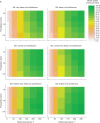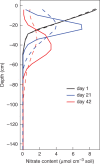Impact of axial root growth angles on nitrogen acquisition in maize depends on environmental conditions
- PMID: 27474507
- PMCID: PMC4998975
- DOI: 10.1093/aob/mcw112
Impact of axial root growth angles on nitrogen acquisition in maize depends on environmental conditions
Abstract
Backgrounds and aims: Crops with reduced requirement for nitrogen (N) fertilizer would have substantial benefits in developed nations, while improving food security in developing nations. This study employs the functional structural plant model SimRoot to test the hypothesis that variation in the growth angles of axial roots of maize (Zea mays L.) is an important determinant of N capture.
Methods: Six phenotypes contrasting in axial root growth angles were modelled for 42 d at seven soil nitrate levels from 10 to 250 kg ha(-1) in a sand and a silt loam, and five precipitation regimes ranging from 0·5× to 1·5× of an ambient rainfall pattern. Model results were compared with soil N measurements of field sites with silt loam and loamy sand textures.
Key results: For optimal nitrate uptake, root foraging must coincide with nitrate availability in the soil profile, which depends on soil type and precipitation regime. The benefit of specific root architectures for efficient N uptake increases with decreasing soil N content, while the effect of soil type increases with increasing soil N level. Extreme root architectures are beneficial under extreme environmental conditions. Extremely shallow root systems perform well under reduced precipitation, but perform poorly with ambient and greater precipitation. Dimorphic phenotypes with normal or shallow seminal and very steep nodal roots performed well in all scenarios, and consistently outperformed the steep phenotypes. Nitrate uptake increased under reduced leaching conditions in the silt loam and with low precipitation.
Conclusions: Results support the hypothesis that root growth angles are primary determinants of N acquisition in maize. With decreasing soil N status, optimal angles resulted in 15-50 % greater N acquisition over 42 d. Optimal root phenotypes for N capture varied with soil and precipitation regimes, suggesting that genetic selection for root phenotypes could be tailored to specific environments.
Keywords: Root architecture; Zea mays; leaching; nitrogen acquisition; precipitation; root growth angles; soil texture.
© The Author 2016. Published by Oxford University Press on behalf of the Annals of Botany Company. All rights reserved. For Permissions, please email: journals.permissions@oup.com.
Figures







Similar articles
-
Theoretical evidence that root penetration ability interacts with soil compaction regimes to affect nitrate capture.Ann Bot. 2022 Feb 11;129(3):315-330. doi: 10.1093/aob/mcab144. Ann Bot. 2022. PMID: 34850823 Free PMC article.
-
Steep, cheap and deep: an ideotype to optimize water and N acquisition by maize root systems.Ann Bot. 2013 Jul;112(2):347-57. doi: 10.1093/aob/mcs293. Epub 2013 Jan 17. Ann Bot. 2013. PMID: 23328767 Free PMC article. Review.
-
Ideotype root architecture for efficient nitrogen acquisition by maize in intensive cropping systems.Sci China Life Sci. 2010 Dec;53(12):1369-73. doi: 10.1007/s11427-010-4097-y. Epub 2010 Dec 23. Sci China Life Sci. 2010. PMID: 21181338 Review.
-
Co-optimization of axial root phenotypes for nitrogen and phosphorus acquisition in common bean.Ann Bot. 2018 Aug 27;122(3):485-499. doi: 10.1093/aob/mcy092. Ann Bot. 2018. PMID: 29982363 Free PMC article.
-
Complementarity in root architecture for nutrient uptake in ancient maize/bean and maize/bean/squash polycultures.Ann Bot. 2012 Jul;110(2):521-34. doi: 10.1093/aob/mcs082. Epub 2012 Apr 19. Ann Bot. 2012. PMID: 22523423 Free PMC article.
Cited by
-
Theoretical evidence that root penetration ability interacts with soil compaction regimes to affect nitrate capture.Ann Bot. 2022 Feb 11;129(3):315-330. doi: 10.1093/aob/mcab144. Ann Bot. 2022. PMID: 34850823 Free PMC article.
-
Auxin synthesis promotes N metabolism and optimizes root structure enhancing N acquirement in maize (Zea mays L.).Planta. 2024 Jan 29;259(2):46. doi: 10.1007/s00425-023-04327-5. Planta. 2024. PMID: 38285079
-
Large Crown Root Number Improves Topsoil Foraging and Phosphorus Acquisition.Plant Physiol. 2018 May;177(1):90-104. doi: 10.1104/pp.18.00234. Epub 2018 Apr 4. Plant Physiol. 2018. PMID: 29618638 Free PMC article.
-
Root phenotypes for improved nitrogen capture.Plant Soil. 2024;502(1-2):31-85. doi: 10.1007/s11104-023-06301-2. Epub 2023 Oct 4. Plant Soil. 2024. PMID: 39323575 Free PMC article. Review.
-
Harnessing root architecture to address global challenges.Plant J. 2022 Jan;109(2):415-431. doi: 10.1111/tpj.15560. Epub 2021 Nov 29. Plant J. 2022. PMID: 34724260 Free PMC article. Review.
References
-
- Azeez JO, Adetunji MT, Lagoke STO. 2006. Response of low-nitrogen tolerant maize genotypes to nitrogen application in a tropical Alfisol in northern Nigeria. Soil and Tillage Research 91: 181–185.
-
- Barber SA. 1995. Soil nutrient bioavailability: a mechanistic approach. New York: John Wiley & Sons.
-
- Boyer EW, Goodale CL, Jaworski NA, Howarth RW. 2002. Anthropogenic nitrogen sources and relationships to riverine nitrogen export in the northeastern U.S.A. Biogeochemistry 57–58: 137–169.
-
- Burton AL, Johnson JM, Foerster JM, et al. 2014. QTL mapping and phenotypic variation for root architectural traits in maize (Zea mays L.). Theoretical and Applied Genetics 127: 2293–2311. - PubMed
MeSH terms
Substances
LinkOut - more resources
Full Text Sources
Other Literature Sources
Research Materials

